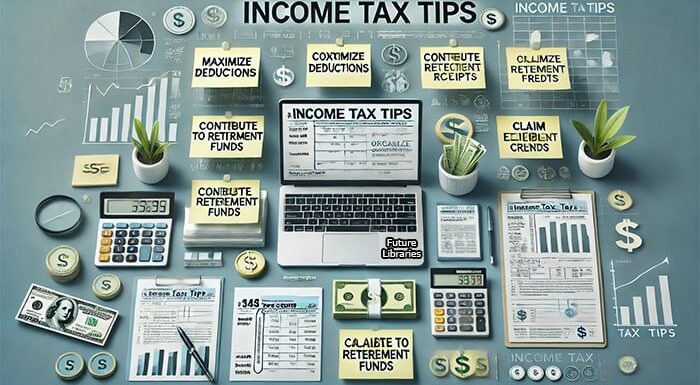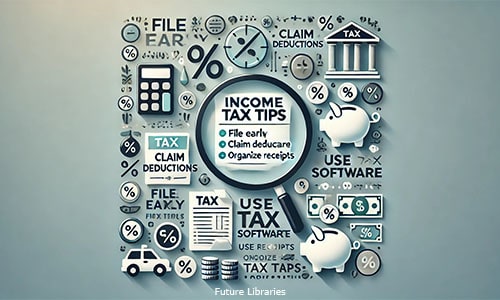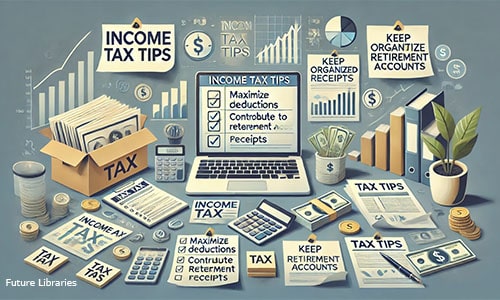
Tax season is upon us once again and whether you’re a seasoned tax filer or you are new to the process, making the most of your tax return can significantly impact your financial future.
Properly navigating all the complexities of the tax system can help you maximize your refund, reduce your taxable income, and avoid costly mistakes that could result in penalties or an audit.
In this blog post, we’ll dive into some of the best income tax tips to ensure you’re in the best financial position possible come tax filing time.
1. Get Organized Early
The key to a smooth tax season is preparation. Begin gathering all necessary documents well ahead of the filing deadline (usually April 15, unless you file for an extension).
Common documents you may need include:
W-2 forms (from employers)
1099 forms (for freelancers, independent contractors, or other non-salaried income)
1098 forms (for mortgage interest)
Receipts for deductible expenses (medical, charitable contributions, etc.)
Proof of education expenses (tuition, books)
Health insurance information (Form 1095)
Having all the required paperwork in hand not only helps you avoid delays but also ensures that you won’t miss any potential deductions or credits. This can sometimes add up to big money!
2. Contribute to Retirement Accounts
One of the most effective ways to reduce your taxable income is by contributing to retirement accounts.
For this tax year, here are some contributions that can help lower your taxable income and save you money:
401(k) Contributions: The maximum contribution is expected to be $22,500 (or $30,000 if you’re 50 or older). Contributions to a traditional 401(k) are made with pre-tax dollars, reducing your taxable income for the year.
IRA Contributions: You can contribute up to $6,500 to a traditional IRA ($7,500 if you’re 50 or older). Depending on your income and whether you or your spouse (if you are married) have a retirement plan at work, you may be able to deduct these contributions from your total taxable income.
Self-Employed Retirement Plans: If you’re self-employed, consider contributing to a Solo 401(k) or SEP IRA. These accounts allow you to contribute much higher limits, offering a significant tax-saving opportunity.
In addition to lowering your tax burden, contributing to retirement accounts ensures you’re saving for your future. It’s a win-win situation.
3. Consider Tax-Advantaged Accounts for Health Expenses
Health Savings Accounts (HSAs) and Flexible Spending Accounts (FSAs) are great ways to reduce taxable income while saving for your healthcare costs.
The contribution limits for these accounts vary each year, but for this year they are as follows:
HSA: You can contribute up to $3,850 for individuals or $7,750 for families. For those 55 or older, there’s a $1,000 catch-up contribution.
FSA: The current limit is expected to be $3,050. You can use these funds to pay for eligible medical expenses with pre-tax dollars.
These accounts not only reduce your taxable income but also allow you to save money on healthcare-related expenses at the same time. Just remember that FSAs may have a “use-it-or-lose-it” rule, while HSAs allow you to roll over unused funds from year to year.
4. Take Advantage of Tax Credits
Tax credits are even more valuable than deductions, as they directly reduce the amount of taxes you owe.
This year, several key credits may apply to your situation, including:
Child Tax Credit: If you have children under 17, you may qualify for a credit of up to $2,000 per qualifying child. This credit is partially refundable, meaning you can still receive a refund even if you don’t owe any taxes this year.
Earned Income Tax Credit (EITC): The EITC is a benefit for low- to moderate-income working individuals and families. Eligibility depends on your income, filing status, and the number of children that are in your household. This credit can be substantial, especially for families with children.
American Opportunity Credit: If you’re paying for higher education expenses, this credit allows you to claim up to $2,500 per student for qualified tuition, fees, and course materials. 40% of this credit is refundable, meaning you can receive up to $1,000 even if you don’t owe any taxes.
Lifetime Learning Credit: This is available for postsecondary education expenses, but it’s less generous than the American Opportunity Credit. You can claim up to $2,000 per return, regardless of how many students are in school.
Don’t overlook the potential tax credits available to you—these can dramatically reduce your tax liability.
5. Take Advantage of Deductions
While tax deductions reduce your taxable income, they don’t lower your tax bill dollar-for-dollar like credits do.
However, there are a variety of different deductions that you might qualify for.
Here are some you may qualify for:
Standard vs. Itemized Deductions: This year, the standard deduction for single filers is likely to increase to $14,500, and for married couples filing jointly, it will be $29,000.
However, if your itemized deductions (like mortgage interest, state taxes, charitable donations, and medical expenses) exceed the standard deduction, then you may benefit from itemizing.
Mortgage Interest Deduction: Homeowners can deduct the interest paid on their mortgage, up to a certain limit. This is especially valuable in the early years of a mortgage when interest payments are typically the highest.
State and Local Taxes (SALT): You can deduct up to $10,000 in state and local taxes paid (including property taxes and state income taxes). However, this cap may limit how much you can benefit from the deduction if you live in a high-tax state.
Charitable Contributions: Donating to qualified charities can be a significant way to reduce your taxable income. For 2025, you may deduct both cash and property donations, but make sure that you keep records and receipts to substantiate all of your claims.
6. Consider a Tax Professional or Tax Software
Although many people are able to handle their taxes themselves with the help of online tax preparation software, there are instances when hiring a tax professional makes sense.
If you have complex finances, multiple income streams, or major life changes (such as a divorce or inheritance), a tax professional can help navigate the situation and ensure that you’re optimizing your tax return.
They can also provide you with personalized advice on strategies for reducing your future tax liability.
That said, if your financial situation is basically straightforward then using tax software can often save you money on preparation fees and the software is incredibly user-friendly these days.
7. Understand Capital Gains and Losses
If you’ve invested in stocks, bonds, or other assets, you may have capital gains or losses. Understanding how these work can help you minimize your taxes.
Long-Term vs. Short-Term Capital Gains: If you’ve held an investment for more than a year, it’s considered a long-term capital gain and is taxed at a lower rate than short-term capital gains (for assets held for less than a year).
Tax-Loss Harvesting: If you’ve experienced losses in your investments, consider tax-loss harvesting, which is selling off losing investments to offset your gains. This strategy can reduce your taxable income and, ultimately, your tax bill.
8. Don’t Forget About Education-Related Tax Breaks
Education-related expenses can result in significant tax savings.
Some opportunities include:
Student Loan Interest Deduction: You can deduct up to $2,500 in interest paid on student loans, even if you don’t itemize. This deduction phases out as your income rises.
529 College Savings Plans: Contributions to 529 plans are not federally deductible, but some states offer state tax benefits for contributions. Additionally, withdrawals for qualifying education expenses are tax-free.
Conclusion
Tax season doesn’t have to be a stressful time of the year if you take the right steps to prepare and understand the various strategies that are at your disposal.
By being organized, contributing to retirement and health accounts, utilizing tax credits and deductions, and considering professional advice, you can help make the most of your tax situation.
Remember, the key to a successful tax season is planning ahead and taking full advantage of the opportunities that the tax code provides.
Whether you’re trying to maximize your refund or minimize your tax liability, these tips can help guide you toward financial success.







Comments are closed, but trackbacks and pingbacks are open.